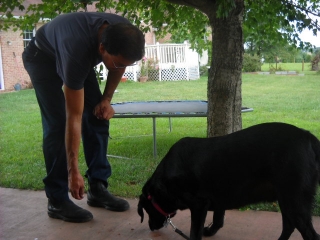Socialization of Adult Puppy Mill Dogs

Why focus on socialization for a 6 year old dog? Surely Doobie is well beyond the early puppy months for critical socializing efforts. According to our own Dr. Ian Dunbar (http://www.dogstardaily.com/training/socialization-with-people) puppies need to be fully socialized to people by the age of three months. Adult puppy mill dogs are special projects that require ongoing efforts, for them to live some sort of a normal life. Sadly,the only socialization they received was staring at four walls. Fortunately, Doobie has proven to be amazingly resilient, yet at the same time, fear rears its` ugly head in a heartbeat if he is placed, according to him, into harms way. The reminders, seeing the fearful body language, screaming go away, are quite wrenching for me. Great care is taken to manage the environment for Doobie, yet some situations just happen.
SAFETY
Every opportunity for socialization is taken in our daily travels. In the accompanying picture, my mechanic was kind enough to take a few minutes out of his busy schedule to toss Doobie some treats. This went well for a number of reasons:
- The stranger was associated with great treats= positive association
- Mark did not reach for Doobie, and stood still.
- Doobie was in charge of the interaction, free to approach/retreat as he chose.
- The interaction began with Doobie a comfortable distance away from Mark.
- The leash was absolutely slack and he was not abruptly marched up to Mark.
- At no time was there any tension on leash/collar.
- Mark was a calm quiet presence doling out treats.
- Doobie was not asked to take treats from a reaching hand, eating them off the sidewalk as he approached.
- There was nobody else standing around or behind Doobie.
For these dogs, it is all about feeling safe in their environments. The latter is a basic need that has to be met, in order for successful learning of new behaviors to take place. This is the root of being able to succeed with these adult undersocialized dogs, being exposed to an alien world.
UNSAFE
Here is an example of a situation that made Doobie feel unsafe. We had been into the quiet country bank a number of times, without incident, usually being the only people inside. I always picked quiet times. The tellers knew his history, and watched from their stations but did not approach. Biscuits were doled out. However, on one occasion, as I was filling out my form, it all went wrong. A group of people came in. A bank employee came out from an office, a large bearded man, and began to talk in a loud voice. As I stepped up to deposit, Doobie had instantly assumed the hunted look that meant he did not feel safe:
- People standing behind and around him.
- People moving closer.
- Strangers looking at him.
- A person reaching out towards him, which had gone unnoticed.
- Strange unfamiliar voices.
- TRAPPED! HELP!! I NEED TO GET AWAY!
I never did make that deposit, quickly exiting the bank, and reinforcing Doobie for some other behaviors near the building, to put a positive spin on an encounter gone badly. Do you know people who are claustrophobic? I imagine it is much the same for Doobie when he feels surrounded. At these times, I feel that I have failed to keep my boy safe.
ADVOCATE
In undertaking the rehabilitation of these special needs dogs, we have also assumed the role of advocates. How could it be otherwise? If we fail to educate people on do’s and don’ts, we are failing at our jobs. We need to discern what our dogs are communicating to us, in order to be successful at socialization efforts. Following are a few links that are amazingly helpful, the first from Nicole Wilde, one of my all time favorite authors. This goes to any client who has a fearful dog.
http://www.cal.net/~pamgreen/interacting_w_fearful_dogs.html
Next, a link from a friend and colleague, whose amazing website, Stacy’s Wag n Train has the following page on stress signals, accompanied by an entire list of other helpful links:
http://www.wagntrain.com/BodyLanguage2.htm
OUTCOME
Will Doobie ever be absolutely free of fear? I doubt it. Can he continue to learn more confident behavior? The last year has proven that he absolutely can, given an environment in which he feels safe. Doobie now routinely attends my classes, is handled by mentored students and is able to greet strangers in our home with confidence. Yet he continues to remind me of what he needs. Good luck in your endeavors; I would love to hear from people with their experiences. Until next time,
Leslie and the labbies.




